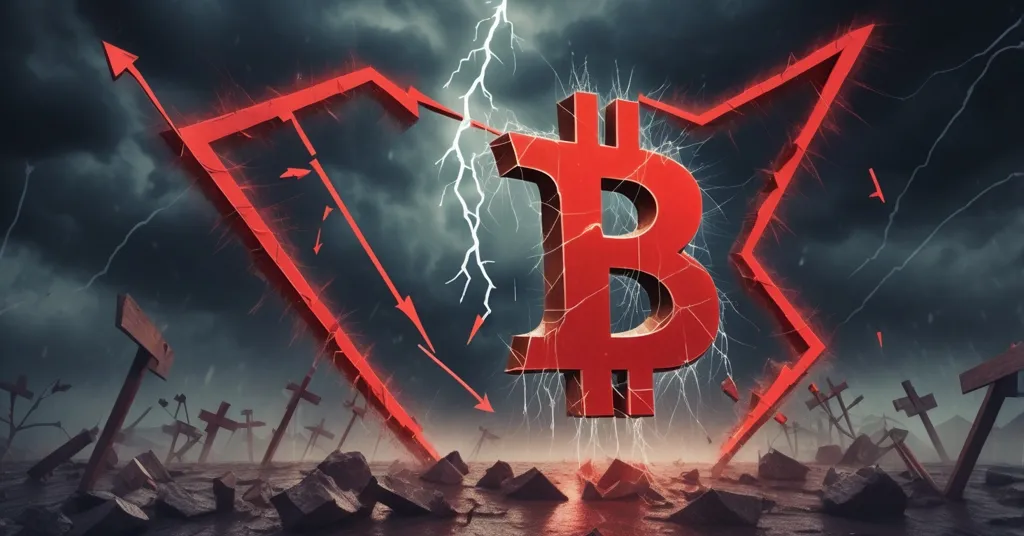Bitcoin Crashes Below $85K: ETF Outflows, Whale Dumps Fuel Bear Market Fears

Bitcoin Price Crash Below $85K: Bear Market Fears and ETF Outflows Explained
Bitcoin has plummeted below $85,000, scraping a low of $82,172—its weakest point since April—following a savage 10% drop in just 24 hours. This nosedive, part of a month-long market rout, has sparked panic across the crypto sphere, with heavy selling from whales, ETF investors, and retail traders fueling fears of a looming bear market.
- Bitcoin tanks to $82,172: A 10% loss in 24 hours, marking a 32% decline from recent highs, one of the steepest corrections in recent memory.
- $19 billion in leveraged positions wiped out: Since October, forced sales have gutted market liquidity, leaving traders exposed.
- Record ETF outflows hit $523 million in a day: November totals near $3 billion, signaling a collapse in retail confidence.
Crypto-Specific Triggers: Whales and Liquidations Unleash Havoc
The crypto market is a battlefield right now, and Bitcoin is taking the heaviest casualties. This price crash isn’t random; it’s a cascade of calculated moves and forced reckonings. Since September, large holders—known as whales—have dumped over $20 billion worth of Bitcoin, according to James Butterfill, Head of Research at CoinShares. That’s not pocket change; it’s a structural blow to market stability. Why are they selling? Speculation runs rampant—some say it’s profit-taking after recent highs, others point to regulatory jitters or portfolio rebalancing. Whatever the motive, the impact is undeniable: thinner liquidity and wider price swings.
Then there’s the carnage from leveraged positions. Over $19 billion in these high-risk bets have been liquidated since October. For the uninitiated, leveraging means borrowing funds to amplify trades, but when prices drop, brokers force-sell assets to cover losses, triggering a downward spiral. This isn’t just a problem for reckless traders (often called “degens” in crypto slang); it drags the entire market into a liquidity swamp, where even small sell orders can cause outsized damage. Options traders are bracing for worse, hedging heavily around $85,000 and $82,000, a clear sign they expect more pain ahead, as highlighted in recent reports on Bitcoin’s dramatic decline.
Retail Panic: Bitcoin ETF Outflows Shake Market Foundations
If whales are the generals abandoning the field, retail investors are the foot soldiers fleeing in droves. U.S. spot Bitcoin ETFs—investment vehicles that let everyday folks buy into Bitcoin’s price without owning it directly—are seeing unprecedented bleeding. A record $523 million flowed out in a single day, with November’s cumulative Bitcoin ETF outflows nearing a staggering $3 billion. Add in Ether ETFs, and the total retail exit hits $4 billion for the month, per JPMorgan analysts. This isn’t institutional money pulling back; it’s the little guy losing faith, and that’s a gut shot to market sentiment.
ETFs were supposed to be crypto’s bridge to mainstream adoption, offering a safe way to invest without wrestling with private keys or shady exchanges. When retail investors bail like this, it’s akin to rats jumping off a sinking ship—it signals deep distrust and worsens liquidity, making price recovery harder. The Bitcoin price drop we’re witnessing isn’t just numbers on a chart; it’s a story of shattered confidence. Who’s left to buy the dip if the average Joe is running for the hills?
Structural Risks: Mining Profitability Crisis Looms Large
Beyond trading floors, Bitcoin’s backbone is under strain. Crypto analyst Jacob King has sounded the alarm on a critical issue: mining profitability is at its lowest in a decade. Bitcoin mining—the process where specialized computers solve complex puzzles to validate transactions and earn new coins—relies on a delicate balance of energy costs, competition, and BTC price. When the reward in Bitcoin is worth less than the electricity bill, miners bleed cash. Many sell their holdings to stay afloat, adding more sell pressure to an already battered market.
“Bitcoin is entering months of chaos,” King warned. “Mining profitability being this low is a structural problem that could drag this market down further.”
King isn’t exaggerating. If smaller miners shut down, only large, well-funded operations survive, risking centralization—a bitter irony for a network built on decentralization. Historically, low profitability periods have led to hash rate drops (a measure of mining power), sometimes slowing transaction processing. Worse, if miners consolidate, Bitcoin’s security could weaken, making it more vulnerable to attacks. This isn’t just a price issue; it’s a threat to the network’s core ethos.
Macro Headwinds: Forces Beyond Crypto’s Control
Bitcoin doesn’t exist in a vacuum, and external forces are piling on the pain. Uncertainty over Federal Reserve policy is a massive overhang—will they cut rates in December to spur risk assets like crypto, or hold firm and choke off liquidity? For those new to economics, rate cuts typically make borrowing cheaper, encouraging investment in speculative assets like Bitcoin. Without them, money stays tight, and risk appetite dries up. Add to that Wall Street volatility tied to Nvidia’s earnings wobbles, and you’ve got a perfect storm. Bitcoin’s correlation with tech stocks has grown, so when Big Tech sneezes, crypto catches pneumonia.
Other global factors are at play too. Persistent inflation fears, potential economic slowdowns, and regulatory whispers—think SEC clampdowns on crypto—keep investors skittish. Long-time Bitcoin critic Peter Schiff has even floated a broader warning: this downturn could spark a liquidity crisis spreading beyond crypto into traditional finance. Given how intertwined markets are today, with hedge funds and institutions dabbling in digital assets, his concern isn’t pure FUD (fear, uncertainty, doubt). It’s a sobering reminder that Bitcoin isn’t the isolated rebel it once was.
Historical Context: Bitcoin’s Volatile Rollercoaster
Before we declare the sky falling, let’s zoom out. Bitcoin’s history is a graveyard of brutal corrections followed by phoenix-like recoveries. In 2018, it crashed 80% from its peak, bottoming out near $3,000 before roaring back to $69,000 by 2021. That same year, it shed 50% in months, only to rebound again. Today’s 32% drop from recent highs stings, but it’s not uncharted territory. Each cycle has tested nerves, separated weak hands from diamond hands (slang for steadfast holders), and ultimately paved the way for new highs.
The difference now? Scale and scrutiny. With institutional players and retail ETF investors in the game, every dip feels like a referendum on Bitcoin’s legitimacy. Recovery timelines vary—2018 took years, 2021 took months. The question isn’t just whether Bitcoin will bounce back, but how long it’ll take in a world of macro uncertainty and tighter wallets.
Debate: Bearish Warnings vs. Bullish Defiance
So, are we staring down a full-blown Bitcoin bear market, or is this just another hiccup? Critics are bleak. Beyond King’s mining concerns, options data shows traders betting on further downside, and Schiff’s liquidity fears paint a grim picture. A 32% haircut isn’t trivial, and with retail confidence crumbling, the road to recovery looks rocky.
Yet Bitcoin’s die-hards refuse to wave the white flag. Former U.K. Chancellor Kwasi Kwarteng dismissed the panic with hodler bravado.
“This pullback is just a chance to stack more Bitcoin for less,” Kwarteng quipped, framing the crash as a discount.
Investor Mike Alfred doubles down on optimism, pointing to Bitcoin’s cyclical nature.
“This is part of Bitcoin’s natural cycle,” Alfred asserted. “I see a rebound to $150,000–$200,000 once conditions stabilize.”
Why the confidence? Bulls often cite catalysts like the upcoming Bitcoin halving (a programmed cut in mining rewards that historically sparks rallies) or potential institutional re-entry once macro clouds clear. But let’s not kid ourselves—pipe dreams of six-figure prices sound hollow when miners are underwater and whales are bailing. Optimism is fine; delusion isn’t. The immediate reality is a market facing serious pressure, not a guaranteed moonshot.
Adoption Implications: Price Pain vs. Bitcoin’s Purpose
This Bitcoin price crash raises tough questions about its adoption narrative. Does a 32% drop scare off mainstream newcomers, or do lower prices lure bargain hunters? On one hand, volatility this severe undercuts the “digital gold” pitch—safe havens don’t swing like a pendulum. On the other, cheaper Bitcoin could draw in fresh blood, especially if paired with education on its core value: a decentralized, censorship-resistant alternative to fiat systems.
At Let’s Talk, Bitcoin, we stand firm on decentralization’s promise as the future of money. We champion financial freedom and disrupting the status quo, but we’re not here to peddle false hope. This market is messy, and shilling absurd “to the moon” predictions amid bloodshed is irresponsible. Adoption grows from honest reckoning—acknowledging Bitcoin’s revolutionary potential while facing its risks head-on. Whether this dip is a buying opportunity or a warning of deeper chaos, navigating crypto demands skepticism and steel.
Key Questions and Takeaways on Bitcoin’s Crash
- Why is Bitcoin’s price crashing below $85,000?
Massive selling by whales ($20 billion since September), $19 billion in liquidated leveraged positions since October, and retail-driven ETF outflows ($3 billion in November) are compounded by macro uncertainties like Fed policy doubts. - Is this the start of a Bitcoin bear market in 2023?
It’s possible, with a 32% drop from highs and bearish trader hedging, though long-term bulls see it as a cyclical dip before an eventual rebound. - How are retail investors driving the crypto market downturn?
They’re pulling $4 billion from Bitcoin and Ether ETFs in November, signaling a profound loss of trust and worsening market liquidity. - Can Bitcoin recover to targets like $150,000–$200,000?
Optimists like Mike Alfred think so, banking on historical recoveries and catalysts like the halving, but near-term hurdles like mining struggles and macro headwinds loom large. - What are the wider risks of this Bitcoin price drop?
Beyond price, a liquidity crisis could ripple beyond crypto, while decade-low mining profitability risks network centralization and deters new investment. - Does volatility undermine Bitcoin’s adoption as digital gold?
It challenges the safe-haven narrative, potentially scaring off mainstream players, though lower prices might attract new entrants if paired with education on its decentralized ethos.
Bitcoin’s current freefall is a brutal test of its dual identity: a transformative force poised to redefine finance, and a volatile beast that can torch the unprepared. We’re rooting for it to emerge stronger, pushing for effective acceleration of decentralized tech, but we’re not blind to the wreckage. This space isn’t for the faint-hearted—it demands grit, critical thinking, and a refusal to swallow hype. Whether chaos or opportunity lies ahead, one thing is clear: Bitcoin’s journey is far from over.



